The interior spaces on the Hindenburg were divided into three main areas:
- Passenger Decks
- Control Car
- Crew Areas
Control Car, Flight Instruments, and Flight Controls
Crew Areas and Keel
The passenger accommodation aboard Hindenburg was contained within the hull of the airship (unlike Graf Zeppelin, whose passenger space was located in the ship’s gondola).
The passenger space was spread over two decks, known as “A Deck” and “B Deck.”
“A” Deck on Hindenburg
Hindenburg’s “A Deck” contained the ship’s Dining Room, Lounge, Writing Room, Port and Starboard Promenades, and 25 double-berth inside cabins.
The passenger accommodations were decorated in the clean, modern design of principal architect Professor Fritz August Breuhaus, and in a major improvement over the unheated Graf Zeppelin, passenger areas on Hindenburg were heated, using forced-air warmed by water from the cooling systems of the forward engines.
Hindenburg’s Dining Room occupied the entire length of the port side of A Deck. It measured approximately 47 feet in length by 13 feet in width, and was decorated with paintings on silk wallpaper by Professor Otto Arpke, depicting scenes from Graf Zeppelin’s flights to South America.
The tables and chairs were designed by Professor Fritz August Breuhaus using lightweight tubular aluminum, with the chairs upholstered in red.
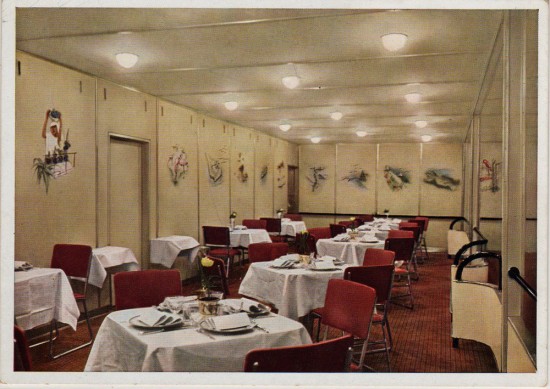
Dining Room of Airship Hindenburg (Airships.net collection)
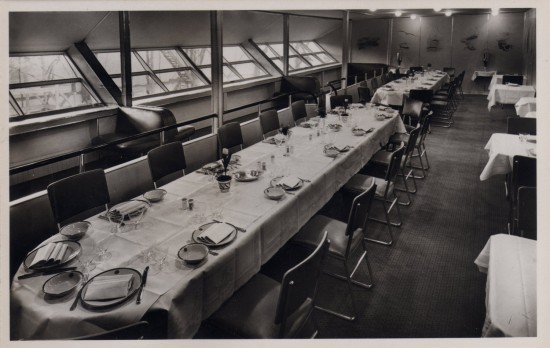
Dining Room of Hindenburg, with Port Promenade (Airships.net collection)
On the starboard side of A Deck were the Passenger Lounge and Writing Room.
The Lounge was approximately 34 feet in length, and was decorated with a mural by Professor Arpke depicting the routes and ships of the explorers Ferdinand Magellan, Captain Cook, Vasco de Gama, and Christopher Columbus, the transatlantic crossing of LZ-126 (USS Los Angeles), the Round-the-World flight and South American crossings of LZ-127 Graf Zeppelin, and the North Atlantic tracks of the great German ocean liners Bremen and Europa. The furniture, like that in the dining room, was designed in lightweight aluminum by Professor Breuhaus, but the chairs were upholstered in brown. During the 1936 season the Lounge contained a 356-pound Bluthner baby grand piano, made of Duralumin and covered with yellow pigskin.
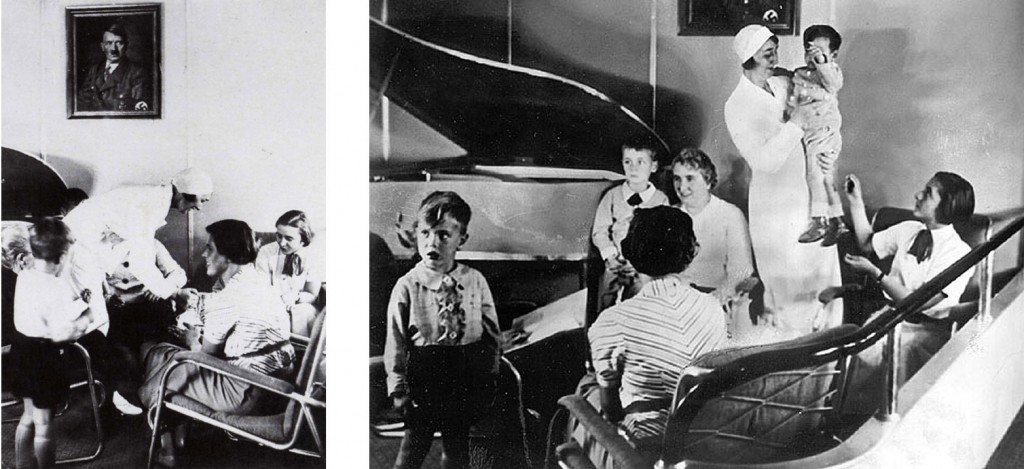
Two views of the Lounge, showing portrait of Hitler and the ship’s duralumin piano. (The stewardess is Emilie Imhoff, who was killed at Lakehurst in 1937.) (©Archiv der Luftschiffbau Zeppelin GmbH, Friedrichshafen)
The piano was removed before the 1937 season and was not aboard Hindenburg during it’s last flight. [Read more about the piano aboard the Hindenburg.]
Next to the lounge was a small Writing Room.
The walls of the Writing Room were decorated with paintings by Otto Arpke depicting scenes from around the world:
Passenger Cabins on Hindenburg
Hindenburg was originally built with 25 double-berthed cabins at the center of A Deck, accommodating 50 passengers. After the ship’s inaugural 1936 season, 9 more cabins were added to B Deck, accommodating an additional 20 passengers. The A Deck cabins were small, but were comparable to railroad sleeper compartments of the day. The cabins measured approximately 78″ x 66″, and the walls and doors were made of a thin layer of lightweight foam covered by fabric. Cabins were decorated in one of three color schemes — either light blue, grey, or beige — and each A Deck cabin had one lower berth which was fixed in place, and one upper berth which could be folded against the wall during the day.
Each cabin had call buttons to summon a steward or stewardess, a small fold-down desk, a wash basin made of lightweight white plastic with taps for hot and cold running water, and a small closet covered with a curtain in which a limited number of suits or dresses could be hung; other clothes had to be kept in their suitcases, which could be stowed under the lower berth. None of the cabins had toilet facilities; male and female toilets were available on B Deck below, as was a single shower, which provided a weak stream of water “more like that from a seltzer bottle” than a shower, according to Charles Rosendahl. Because the A Deck cabins were located in the center of the ship they had no windows, which was a feature missed by passengers who had traveled on Graf Zeppelin and had enjoyed the view of the passing scenery from their berths.
Promenades On either side of A Deck were promenades, featuring seating areas and large windows which could be opened in flight.
“B” Deck on Hindenburg
B Deck on Hindenburg, located directly below A Deck, contained the ship’s kitchen, passenger toilet and shower facilities, the crew and officers’ mess, and a cabin occupied by Chief Steward Heinrich Kubis (containing a door to the keel corridor, which was the only connection between passenger and crew spaces).
During the winter of 1936-1937, while the ship was laid up in Frankfurt, additional passenger cabins were also added in Bay 11, just aft of ring 173. The new cabins had windows offering an outside view, and were slightly larger than the cabins on A Deck. The additional weight of these new cabins was made possible by the unexpected (and unwelcome) need to operate the ship with hydrogen, which has greater lifting power than the helium for which Hindenburg had been designed.

B Deck, showing 1937 cabins. (Drawing courtesy Patrick Russell, “Faces of the Hindenburg” blog, based on 1937 DZR brocure.)
Perhaps most surprising, aboard a hydrogen airship, there was also a smoking room on the Hindenburg. The smoking room was kept at higher than ambient pressure, so that no leaking hydrogen could enter the room, and the smoking room and its associated bar were separated from the rest of the ship by a double-door airlock. One electric lighter was provided, as no open flames were allowed aboard the ship. The smoking room was painted blue, with dark blue-grey leather furniture, and the walls were decorated with yellow pigskin and illustrations by Otto Arpke depicting the history of lighter-than-air flight from the Montgolfiers’s balloon to the Graf Zeppelin. Along one side of the room was a railing above sealed windows, through which passengers could look down on the ocean or landscape passing below.
The smoking room was perhaps the most popular public room on the ship, which is not surprising in an era in which so many people smoked.

Pressurized Smoking Room aboard LZ-129 Hindenburg, showing door to the bar, with the air lock doors beyond. (Airships.net collection)
The Hindenburg’s bar was a small ante-room between the smoking room and the air-lock door leading to the corridor on B-Deck. This is where Hindenburg bartender Max Schulze served up LZ-129 Frosted Cocktails (gin and orange juice) and Maybach 12 cocktails (recipe lost to history), but more importantly, it is where Schulze monitored the air-lock to ensure that no-one left the smoking room with burning cigarattes, cigars, or pipes. Schulze had been a steward and bartender aboard the ocean liners of the Hamburg-Amerika Line and was well liked by Hindenburg passengers, even if he was surprisingly unfamiliar with basic American cocktails such as the Manhattan. The bar and smoking room were also the scene of a raucous party on the Hindenburg’s maiden voyage to America, where passenger Pauline Charteris improvised a kirschwasser cocktail after the ship ran out of gin for martinis.
For the interior of Hindenburg’s hull, where crew spaces were located, and the inside of the ship’s control car, visit:






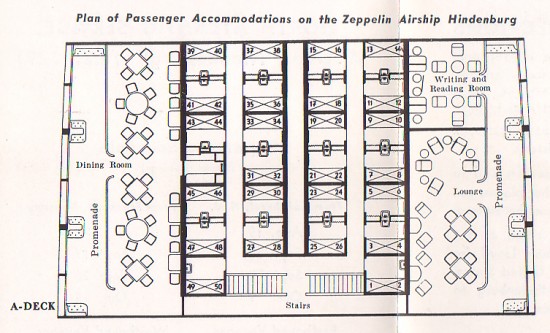








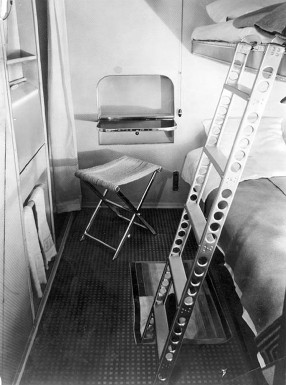

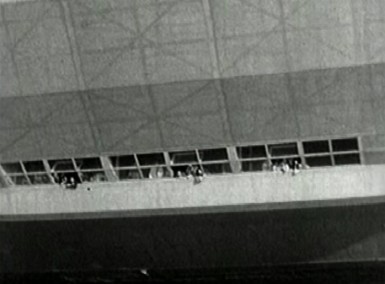



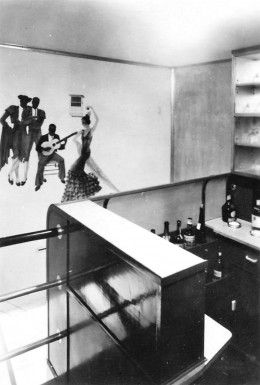

I can’t believe it took me FIFTY-SEVEN years to learn about the Hindenburg! Absolutely fascinating! I never even knew it had more than just a flight crew, let alone luxurious accommodations of the day! Thanks for the wonderful article!
It’s like a cruise ship in the sky, without the water slides and pool cant forget the balcony cabin.
It is so so sad with all those lives lost. 🙁
Where the doors locked during the flight? I mean the cabins or the purser’s office.
Thanks for the article. I remember being a kid watching documentaries on the Hindenburg and the 1975 film The Hindenburg and wondered, how did they put a smoking room in a hydrogen fill airship?
Your website has great information, photographs, and drawings. I just toured the Lakehurst base and Hindenburg crash site today and your website filled in a lot of gaps. Thanks.
What was on the menu in the dining room and did the chefs cook with electric heat?
Yes, the ovens and range were all electric. I own a lot of Hindenburg menus and I have been meaning to do a blog post showing them; just not enough time!
How did the 62 survivors escape the inferno? Did most jump before the zeppelin hit ground or did the cabin wallls and ceiling protect them somehow?
Most jumped while the aircraft was above the ground; a few left (or were assisted in leaving) after it settled on the ground. The cabin walls were fabric and foam and very quickly burned. Nothing was left of the passenger compartment other than some remnants of metal framework.
Most smashed the windows on the promenade decks and jumped seconds before it hit the ground. Some had broken bones when they hit the ground, but luckily, most escaped. Just saying if you didn’t already search it up.
Many of the windows were able to be opened; I am not sure if any were smashed or how easy that would have been to do, but yes, many people survived by jumping out promenade windows.
No one smashed any windows. Do your research.
My mother and father witnessed the Hindenburg fly over ‘Germantown’ aka West Roxbury and Dedham Massachusetts. We have photos but unsure of the year.Many Ruer Valley Germans settled in Boston in the 1880’s
Fascinating. I had no idea the toilets were such a slog to get to. I would have wanted my money back, but likely would have been dead. Oh well!
If you were familiar with Pullman Sleeping Cars on trains of that era, most passengers would wear bathrobes and slippers and have to go to the men’s or women’s {lounge) at either end of the coach to use a toilet or use a shower. It was also typical of boarding… Read more »
This is true about boarding houses.My Polish immigrant grandparents married and lived in a boarding house for almost 15 years before they bought their first home. My dad was almost 9 years old, the youngest. My grandmother gave birth to 3 boys while living in the boarding house!. She actually… Read more »
Out of 96 people on board, only 30 + died, not bad for such an incident. Let’s not forget that since the early 1900s, German Zeppelins, using hydrogen, had an amazing safety record, the Graf carried over 40,000 passengers in its career with not one life lost or hurt. They… Read more »
Great piece of research, well done. I am researching the Hindenburg as it came to the Isle of Man where I live. An amazing site by all who saw her. I have the old news paper reports. Well done, Bill Henderson.